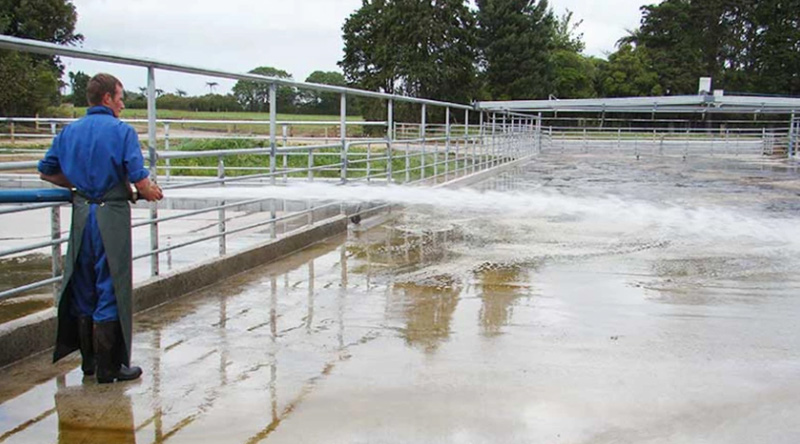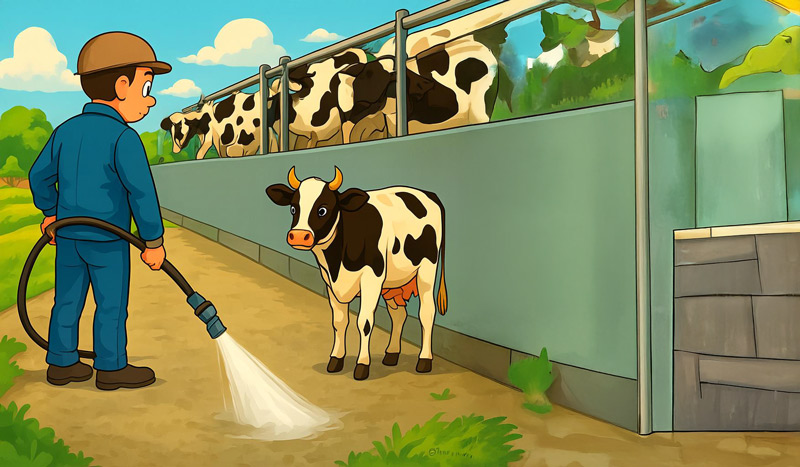Obligation FREE Site Visit
To arrange for an obligation FREE site visit please call Diamond Grind on
.Why Polyurethane Cement is the Future of Dairy Floors
By Concrete Floor Specialists with a Passion for serving Farmers
A Farmer’s Tale – The Day Everything Slipped Away
Picture this: It’s just after dawn at a small dairy farm nestled between the hills and waterways of the NSW Central Coast. The cows are lined up, waiting patiently for milking to begin. A farmer, let’s call him “Tom”, grabs his hose and starts power washing the concrete floor before the day begins.
Suddenly — slip. He lands hard. The pain shoots through his leg, and he knows this isn’t going to be just another morning. As he limps off to rest, one thought keeps running through his head: “This floor has seen better days.”
Now imagine Tom walking into his vet’s office a few days later, only to find one of his cows has also suffered an injury — a twisted hock, likely from slipping on the same worn-out floor.
While this story might not be real, it could easily be someone’s reality. And that’s what makes choosing the right flooring system for your dairy so important.
DiamondGrind are concrete floor specialists who work closely with farmers throughout NSW, helping them upgrade their dairies with durable, safe, and long-lasting flooring solutions. Over the years, We have seen how poor flooring choices can lead to costly repairs, animal injuries, and safety hazards.
That’s why today, we are writing about something that’s changing the game in dairy construction: polyurethane cement.
Understanding Concrete Floors in Dairy Construction
What Is Polyurethane Cement?
Polyurethane cement (PUC) is a high-performance flooring solution that blends polyurethane resins with cement to create a seamless, ultra-durable surface.
Unlike traditional epoxy coatings, which can peel or crack under stress, PUC offers:
- Exceptional chemical resistance
- Slip-resistant finishes
- Thermal shock tolerance
- Fast return-to-service times (as little as 24–48 hours)
It’s designed specifically for environments where hygiene, durability, and safety are non-negotiable — like a working dairy (you can see a comparison of some floor surfacing types here).
A Short History of Concrete and Dairy Floors
Concrete has been the foundation of dairy flooring for over a century. It’s strong, cost-effective, and easy to install. But as farming practices evolved, so did the demands placed on flooring systems.
In the past, basic concrete slabs were the norm. They worked — but they had serious drawbacks:
- Porous surfaces that trap bacteria
- Cracking due to hoof traffic and cleaning chemicals
- Slippery when wet, posing risks to both humans and animals
As hygiene standards improved and animal welfare became a bigger focus — especially in Australia post-2000s — it was clear that new flooring options were needed.
Why Concrete Still Matters Today
Despite newer materials entering the market, concrete remains the go-to base material for most dairies. Here’s why:
- Durability: With proper care, concrete floors can last decades.
- Affordability: Compared to other industrial flooring options, concrete is budget-friendly.
- Hygiene: When sealed correctly, concrete can be non-porous and easy to clean.
- Thermal Mass: Helps regulate internal temperatures in milking sheds.
But raw concrete alone isn’t enough. That’s where polyurethane cement comes in — transforming ordinary concrete into a high-performance, hygienic, and slip-resistant surface.
Trends & Developments – Staying Ahead in Dairy Floor Technology
Government Incentives and Industry Standards
The Australian government has ramped up its support for sustainable agriculture. Programs like, the NSW Department of Primary Industries Smart Farms Program, have offered grants to farmers upgrading infrastructure to meet environmental and safety standards. Many dairies applied for funding to replace old concrete floors with polyurethane cement systems.
Additionally, Australian Standard AS 2622-2021 outlines guidelines for slip-resistant surfaces in agricultural environments. Polyurethane cement easily meets and exceeds these standards, making it a smart choice for compliance and safety.
Sustainability and Eco-Friendly Practices
There’s a growing trend toward eco-conscious dairy floor solutions. Newer polyurethane cement systems now feature low VOC (volatile organic compound) formulas, making them safer for farmers, animals, and the environment.
Some manufacturers are also incorporating recycled aggregates into their mixes, reducing the carbon footprint of each installation. As consumer demand for sustainable dairy products grows, farms that adopt green building practices will find themselves ahead of the curve.
Imagined Case Study: A Modern Makeover for a Family Farm
Let’s imagine a family-owned dairy near Taree. Their 30-year-old concrete floor was cracked, slippery, and difficult to keep clean. After consulting with a local concrete specialist, they decided to upgrade to a polyurethane cement system.
Within weeks of the upgrade:
- Slip-related incidents dropped dramatically
- Cleaning time was reduced by nearly a third
- Odours decreased significantly
- Cows showed improved comfort and mobility
They even noticed fewer vet visits related to hoof issues — a major win for productivity and animal welfare.
While this case study is fictional, it reflects real outcomes we see across the industry.
FAQs – Everything You Need to Know About Polyurethane Cement in Dairies
Is polyurethane cement expensive compared to regular concrete?
Upfront, yes — it costs more than standard concrete or epoxy coatings. However, its durability and minimal maintenance make it more cost-effective in the long run.
How long does polyurethane cement last in a dairy?
With proper installation and care, PUC floors can last 15–20+ years — significantly longer than traditional coatings.
Can it be applied over existing concrete?
Absolutely! One of the biggest advantages of PUC is that it can be applied directly over damaged concrete after proper preparation and repair.
Is it safe for cows?
Yes — in fact, it’s safer than untreated concrete. Its textured finish provides traction, reducing slips and injuries. Plus, it’s non-toxic and easy to keep clean.
How long does installation take?
Most dairy installations can be completed in 2–3 days, depending on size. Farmers can usually resume operations within 48 hours.
Can it withstand heavy machinery and cow traffic?
Definitely. PUC is designed for high-impact, high-traffic environments — perfect for milking parlours and holding yards.
Expert Tips from a Central Coast Concrete Specialist
Over the years, DiamondGrind has worked with many dairy farmers, helping them upgrade their facilities. Here are my top tips for those considering polyurethane cement:
- Don’t Cut Corners on Surface Preparation
You could have the best product in the world, but if the substrate isn’t prepped properly, it won’t stick. Make sure the existing concrete is shot-blasted or diamond-ground to create a solid mechanical bond. - Choose the Right Texture for Your Needs
Not all textures are created equal. Talk to us about the right finish — whether it’s fine grain for calf pens or coarse grip for holding yards. - Go for a Seamless System
Joints are trouble spots. Stick with a fully bonded, seamless application to prevent bacterial growth and reduce tripping hazards. - Work with Certified Applicators
This isn’t a DIY job. Use applicators who are certified by the manufacturer and experienced in dairy applications. We know how to handle the challenges unique to farming environments. - Plan Around Milking Schedules
Timing is everything. Schedule installations during quieter periods or dry seasons to avoid disruptions and ensure optimal curing conditions. - Add Drainage Channels Where Needed
Even the best flooring can’t do miracles if water pools. Consider adding sloped channels or trench drains during installation to improve water flow and reduce standing water. - Use UV-Stable Products Indoors and Out
If your flooring will be exposed to sunlight (like in open-air holding areas), make sure your PUC system includes UV protection to prevent discolouration and degradation.
Invest in Safety, Hygiene, and Longevity Today
Dairy farming is demanding work — and every detail counts when it comes to efficiency, safety, and animal health. Polyurethane cement might seem like a small change, but it can make a massive difference in how your dairy operates day in and day out.
From reducing injuries and improving cleanliness to cutting down on maintenance costs and increasing longevity, PUC is proving itself as the superior choice for modern dairy flooring on the Central Coast and beyond.
If you’re still relying on cracked, slippery concrete, now’s the time to upgrade. Talk to a local specialist, explore government grants, and start planning your next flooring project.
Ready to Upgrade Your Dairy Floor?
We would d love to hear from you! Whether you’ve got questions about polyurethane cement, want to share your own experience with dairy flooring, or are curious about working with a local concrete floor specialist. Let’s make our dairies safer, cleaner, and more efficient — one slab at a time.

✅ Let's Talk — DiamondGrind
100% free consultation — no commitment required.
